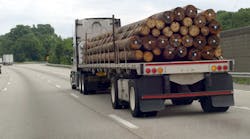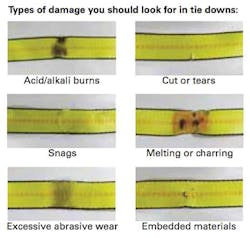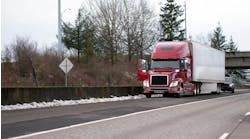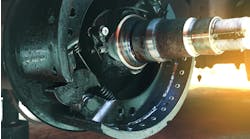Basic cargo securement rules to increase safety and prevent downtime
FleetOwner recently covered the latest trends and equipment to keep cargo safe and secure, from automated decking systems to futuristic lightweight materials that can replace steel chains. But even as cargo securement becomes safer and easier, getting the basics right can have a far more dramatic impact.
The first thing to know is that there are specific rules to follow—and those rules, like properly packed cargo, have been firmly in place for a while. From a regulatory standpoint, not much has changed since the Federal Motor Carrier Safety Administration (FMCSA) installed new rules that took effect in 2004.
They were based on the North American Cargo Securement Standard Model Regulations.
The general rule states that: “Cargo must be firmly immobilized or secured on or within a vehicle by structures of adequate strength, dunnage (loose materials used to support and protect cargo) or dunnage bags (inflatable bags intended to fill space between articles of cargo or between cargo and the wall of the vehicle), shoring bars, tiedowns or a combination of these.”
Getting more granular, the cargo rules call for one tiedown for items 5 ft. or less in length and under 1,100 lbs. Two tiedowns are required for articles 5 ft. long or less and more than 1,100 lbs., or 5 to 10 ft. long regardless of weight. An extra tiedown is required for every additional 10 ft. This means a pile of 40-foot-long steel pipes would require five tiedowns.
The essence of these rules is to keep freight in compliance with the Sir Isaac Newton’s Second Law of Motion, which addresses force, mass, and acceleration. Loads must withstand 0.8 g (gravitational force equivalent) of deceleration moving forward, 0.5 g acceleration rearward, and 0.5 g acceleration laterally (when turning).
The rules also call for tagging and stenciling of working load limit (WLL), referring to the maximum allowable load for each tie down.
New rules and addendums can be suggested and debated at North American Cargo Securement Harmonization Public Forum or petition the FMCSA directly. In 2012, one company brought up how regulations for stacking dressed lumber could be made safer and more secure. The FMCSA granted the exemption in 2015.
In 2019, the FMCSA gave an exemption to Groendyke Transport to have an extra amber brake-activated pulsating lamp on its bulk containers in addition to the mandated steady-burning brake lamps. The extra visual cue was found to help motorists keep a safer distance behind the slowing trucks.
"Our data shows that it has played a significant role in decreasing the number of rear-end collisions due to distracted driving," said Brian Gigoux, Groendyke Transport vice-president of equipment and maintenance, at the time. "This is not just a win for Groendyke Transport; it’s a win for the safety of the motoring public.”
Officers from the Commercial Vehicle Safety Alliance (CVSA) check enforce these rules during their routine roadside inspections of tractor-trailers and their drivers. Compliance with cargo securement rules is still a top issue. During CVSA’s 2019 International Roadcheck, about 18% of trucks stopped during the three-day blitz were taken out of service for critical vehicle inspection item violations. Of those 12,019 vehicles, 12.2% were removed for cargo securement violations, right behind braking systems and adjustments (45%) and tires and wheels (19.3%). This is a marked improvement over the 2017 Roadcheck’s 15.7% cargo securement violation share. Cargo securement was the area of focus in 2017 (2019 was steering and suspension).
“In general, what we see most often are pieces of debris are part of a load that will become unsecured and fall from a commercial motor vehicle or even a non-commercial motor,” said Chris Turner, CVSA director of crash and data programs.
While these might not be big enough to be the direct cause of a fatality incident, they can increase the likelihood of such an event. Turner said in his years as Kansas Highway Patrol captain, new drivers not used to objects hitting their windshield and older drivers with declining senses and reaction time are most susceptible to crashes involving unexpected hazards.
CVSA does not have specific data relating to cargo securement-related fatalities, though is currently working with stakeholders to record that data.
That could go a long way in guiding fleets and manufacturers as to how to improve cargo safety, though Turner had already noticed positive cargo equipment changes in recent years.
“In the first 10 to 15 years of my career, there weren’t many changes—a chain was a chain and synthetic webbing was synthetic webbing,” Turner said. “Over the last five to seven years, the advances in those different types of technologies to ensure cargo securement and algorithms used to determine if [boxes are stacked safely] safe are absolutely going in the right direction.
“The trick now will be, just like it is in automated vehicles, to make sure that folks know how to properly use that technological ability to their advantage,” he added.
Investing in state-of-the-art materials and equipment certainly help, but routine checks of any strap’s condition not only help secure the load, but can also prevent unplanned downtime due to a failed CVSA inspection.
“It might be just a small cut, but it does have a dramatic impact on the strength of the tie down,” explained Ralph Abato, president and managing director of Doleco USA.
Here are some examples to look for:
And having some extra straps onboard is also a smart move, as webbing can become frayed or damaged on the road, if for example, the material rubs up against a sharp metal edge.
“If it was determined that you had some straps that were had some defects and they were being pulled out of service, you're either going to have to sit there and wait till somebody brings you some because they won't let you drive without enough tie downs,” Abato said. “That would be the perfect time to say, ‘Hey, I've got a couple of brand new ones here; it's time to break them out.”





